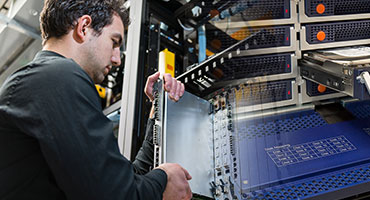Serverless: The future of cloud computing?

While the cloud lends companies more agility, New York Times CTO Nick Rockwell says event-triggered computing cuts cost and enables more efficient application development. Welcome to the serverless era.
The cloud has been a boon for many companies, enabling CIOs to turn off servers or even shutter data centers. CIOs rent processing power, storage and other tools from a mix of vendors in a quickly growing market. But a small contingent of IT leaders is looking to a more efficient way to rent computing horsepower. Rather than take on the often onerous obligations of designing and managing cloud architecture, they are going “serverless.”
With serverless computing, cloud instances are no longer allocated, only to sit idle until called upon to fuel applications and other functions. Rather, resources are provisioned only when a specific event occurs. A textbook example of event-based computing is the internet of things (IoT), with sensor-based devices reacting to triggers on the fly. And when a user accesses a mobile app from his or her smartphone — an event — virtual machines in the cloud retrieve and serve up the information.
New York Times CTO Nick Rockwell is convinced that serverless, also known as "function as a service" (FaaS), represents the next leg in the cloud journey, enabling developers to focus on writing code rather than worrying about the servers it will run on. "Serverless makes products both reliable and scalable," Rockwell tells CIO.com. "In the long term, economically, it's going to be a far better, far cheaper, far more efficient way to go."
Juggling a cloud, or two, or three
It's a forward-looking position considering Rockwell is still migrating the Times to traditional cloud services. When Rockwell joined from Conde Nast in 2015, the Times was connecting its computing infrastructure to Amazon Web Services' Virtual Private Cloud, which allows enterprises to connect their data center to a virtual private cloud within AWS. And it lacked a complete content delivery network (CDN) to store content at the “edge,” closer to consumers’ computing devices.
Today, the Times is largely split between two clouds: AWS runs most of the Times' corporate applications and ecommerce platform, while Google Cloud Platform (GCP) powers consumer-facing applications, including NYTimes.com, the Times mobile app and the Times crossword puzzle. The Times also has a cloud CDN courtesy of Fastly, which ensures that consumers can access Times websites and apps by keeping an updated copy of those services, a hedge against system outages.
The cloud migrations have helped, but managing them remains a chore. Rockwell’s infrastructure teams must still figure out how many AWS and GCP instances they need, how large those instances should be, and whether instances will require additional inputs, outputs, or memory. They then need to configure each instance, and patch and install software on the operating systems. Plus, they must carefully manage dependencies associated with each application, and figure out how each part of an app scales.
"The resource utilization and optimization falls to the customer," says Rockwell, echoing a lament voiced by many CIOs over the years. "If we rent 50 instances and if one is fully loaded and the other 49 are idle, that's our problem."
The potential of serverless
Hence Rockwell's brewing interest in serverless, which renders moot the problem of idle instances. Instead, when a pre-defined event occurs, code written specifically to execute a function is triggered, and the serverless platform performs the task. Customers don't need to tell the cloud vendor how many times these functions will be triggered, and they pay a fraction of a penny every time a function is executed.
Due to the waste in idle cloud instances, Rockwell says serverless can potentially yield 5x to 10x in efficiency gains. "Given a healthy competitive dynamic, a lot of those savings will come back to users,” says Rockwell.
Whether serverless becomes the Next Big Thing in computing remains to be seen. Gartner says that more than 90 percent of serverless deployments will occur outside IT departments' infrastructure and operations groups. And vendors are seeking to capitalize on the interest of brands such as the Times and General Electric, whose CTO Chris Drumgoole has also expressed his enthusiasm for the serverless model.
AWS launched AWS Lamba as its first commercial serverless platform in 2014. Comparable offerings from Microsoft and Google should bolster competition, creating more choice for customers. Rockwell is currently running the Times crossword puzzle and other apps using serverless in Google’s App Engine, though he plans to run more apps in this fashion over time.
Rockwell isn't committing to any one serverless platform, but he favors Google's engineering prowess, combined with its container management capabilities and platform-as-a-service (PaaS) products.
Most cloud platforms make software agnostic, enabling developers to make decisions on how to design and solve problems correctly. But Google's approach is "opinionated," essentially picking architecture design options, such as programming languages, and sticking with them. Moreover, it's trying to build an ecosystem of opinionated products designed to work together, Rockwell says. While more choice has, as a rule, been a developer's preference, fewer choices actually helps minimize the cost associated with planning, designing and building an architecture from scratch.
"Google has the best serverless story right now," Rockwell says. "We've been a little bit on the bleeding edge with Google but so far it's worked out well."




